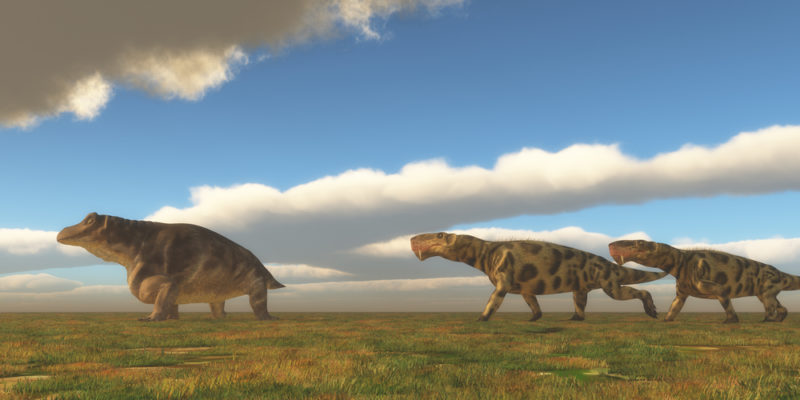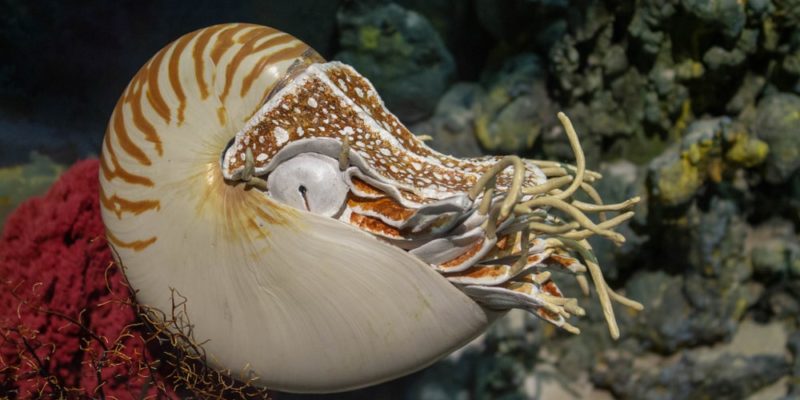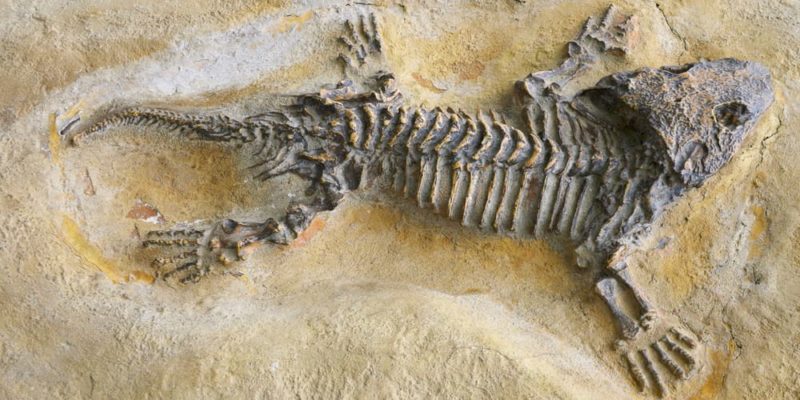We explore the Permian Period, and discuss its characteristics and landscape features. In addition, we describe its climate, flora and fauna.

What was the Permian Period?
The Permian is the last period of the Paleozoic Era, which spanned from 540 to 248 million years ago. The Permian Period succeeds the Carboniferous and precedes the Triassic Period of the Mesozoic Era.
The Permian began 290 million years ago and ended 248 million years ago, spanning a total interval of 42 million years. During this period, the largest mass extinction event in Earth’s history took place, known as the Permian-Triassic extinction.
In Permian time the continental crust was conjoined, forming a single supercontinent called Pangea. During the early part of the Permian, the climate was warm and humid, as it had been in the Carboniferous, but over the course of geologic time, humidity significantly decreased and the planet became more arid.
The name of the period comes from the Russian city of Perm, where in 1841 English geologist Roderick Murchison (1792-1871) identified and classified fossils dating from this period.

- See also: Jurassic Period
Characteristics of the Permian Period
The main characteristics of the Permian Period are:
- It began 290 million years ago and ended 248 million years ago.
- The continental crust formed a single supercontinent called Pangea.
- It experienced numerous climatic shifts, from glaciations in the early part of the period to a warm and humid climate spreading throughout of the period.
- Some continental regions had a warm and dry climate.
- Flora and fauna were highly diverse, both on land and sea.
- It ended with a major mass extinction event, which virtually wiped out all animal life on Earth.
Division of the Permian Period
The Permian is divided into three epochs or series comprising nine ages or stages, as follows:
- Cisuralian Epoch. It began around 298.9 million years ago and ended about 279.3 million years ago. It comprises the Asselian, Sakmarian, Artinskian, and Kungurian ages.
- Guadalupian Epoch. It began about 272.9 million years ago and ended about 265.1 million years ago. It includes the Roadian, Wordian, and Capitanian ages.
- Lopingian Epoch. It began around 259.1 million years ago and ended about 254.2 million years ago, marking the end of the Permian Period and the Paleozoic Era. It encompasses the Wuchiapingian and Changhsingian ages.
Geology of the Permian Period
During the Permian Period Pangea was formed, a supercontinent made up of all the landmasses on the planet. Thus, most landmasses formed a single block, greatly influencing the distribution of plant and animal life on Earth at the time.
The Permian witnessed the Hercynian or Variscan orogeny, resulting from the collision of the continents that formed Pangea. This caused the formation of mountain ranges such as the Appalachian Mountains in North America and the Scandinavian Mountains in Europe.
There were episodes of massive volcanic activity throughout the period, releasing large amounts of gases and particles into the atmosphere. These volcanic events would have contributed to climatic and environmental changes, as well as to the mass extinction that occurred at the end of the Permian.
Climate of the Permian Period
During the early part of the Permian, the climate was extremely cold, as the period started in the wake of the glaciations that took place in the late Carboniferous. Over time, it became warmer and more humid, and as a consequence, glaciers retreated and sea level rose.
Following the formation of Pangea, vast expanses of continental landmass became far removed from the sea, giving rise to a hot desert climate in those areas with significant fluctuations between wet and dry seasons.
Towards the end of the Permian Period temperatures fell sharply. This would have been caused by large amounts of ash from massive volcanic activity thrown into the atmosphere, which would have blocked sunlight. The resulting lack of light and heat would have been one of the causes of the mass extinction event that occurred towards the end of the Permian.
Flora and fauna of the Permian Period

The extensive forests and rainforests that formed during the Carboniferous Period continued into the Permian, ensuring an atmosphere rich in oxygen. In wetter areas, warm and humid climate ecosystems continued to form, while in the drier interior of Pangea, flora and fauna adapted to the lack of humidity began to appear.
In terms of fauna, insects evolved to their modern appearance and, since aerial vertebrates did not yet exist, they conquered the skies. In addition, a number of amphibians adapted completely to life outside water, and towards the end of the period archosaurs appeared, which would later give rise to crocodiles, pterosaurs, and dinosaurs in the Triassic Period.
In the seas, plankton recovered from the Devonian extinction, and nautiloids, echinoderms, mollusks, and brachiopods flourished. Bony fishes and primitive sharks evolved, emerging as major predators.
Towards the end of the period, the mesosaur appeared, a reptile that inhabited present-day South America and Africa. This species was conclusive evidence for the formulation of the theory of continental drift, which proposed the hypothesis of the movement of continents.
Among the species from the Permian to have left a quite complete fossil record to the present day are:
- Nautilus. Originating in the waters of Micronesia, it is one of the few organisms that survived the Late Permian extinction event and has changed little over its 270 million years of evolution. It is a round-shaped cephalopod mollusk, considered a living fossil.
- Dimetrodon. This now extinct genus of synapsid reptiles (mammal-like reptiles) had a huge dorsal sail consisting of elongated vertebral spines with a membranous tissue between them.
- Ginkgo biloba. Another living fossil, this tree with yellow, bifurcating leaves first appeared 280 million years ago. Today, it can grow to a height of 98 feet (30 m) over its nearly thousand-year lifespan. Its leaves are used as medicinal herbs.
Permian-Triassic extinction event

The Permian Period ended with the largest mass extinction event in the history of Earth, both in terms of the number of species lost and the impact on subsequent fauna. Only 5% of the species survived: 96% of marine species and 99% of terrestrial species disappeared as a consequence of this mass extinction.
While the exact causes of such a catastrophic event are unknown, various hypotheses have been put forward:
- Contamination of the atmosphere with sulfur and carbon dioxide caused by volcanic activity.
- The impact of an asteroid, which may have had devastating effects on the flora and fauna of the time.
- The release of hydrogen sulfide (a powerful toxic agent) in marine waters caused by the proliferation of anaerobic bacteria due to oxygen depletion.
- Ash from massive volcanic activity released into the atmosphere, which would have darkened the sky, leading to a sharp drop in temperature and a reduction in photosynthesis processes. This would have caused an increase in the amount of carbon dioxide and a decrease in oxygen levels.
It is believed that the extinction would have been gradual, lasting between 80,000 and 200,000 years.
Explore next:
References
- National Geographic. (2011). La Extinción Masiva se prolongó por 200.000 años. https://www.nationalgeographic.es/
- National Geographic. (2022). Período Pérmico. https://www.nationalgeographic.es/
- Tarbuck, E. y Lutgens, F. (2005). Ciencias de la Tierra. Una introducción a la geología física. Pearson Educación.
Was this information useful to you?
Yes NoThank you for visiting us :)